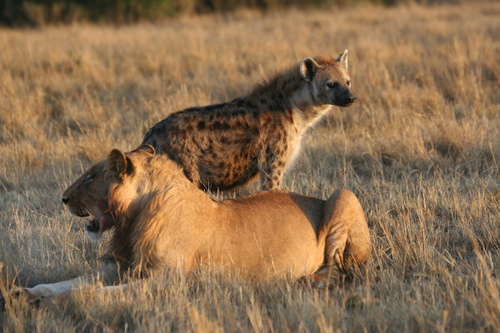|
Fitness-density Covariance
The fitness-density covariance (also known as *growth-density covariance*) is a coexistence theory, coexistence mechanism that can allow similar species to coexist because they are in different locations. This effect will be the strongest if species are completely segregated, but can also work if their populations overlap somewhat. If a fitness-density covariance is operating, then when a species becomes very rare, its population will shift to predominantly locations with favorable conditions (e.g., less competition or good habitat). Similarly, when a species becomes very common, then conditions will worsen where they are most common, and they will spread into areas where conditions are less favorable. This negative feedback can help species avoid being driven extinct by competition, and it can prevent stronger species from becoming too common and crowding out other species. Along with storage effects and relative nonlinearity, relative nonlinearities, fitness-density covariances ... [...More Info...] [...Related Items...] OR: [Wikipedia] [Google] [Baidu] |
Coexistence Theory
Coexistence theory is a framework to understand how competitor traits can maintain species diversity and stave-off competitive exclusion even among similar species living in ecologically similar environments. Coexistence theory explains the stable coexistence of species as an interaction between two opposing forces: fitness differences between species, which should drive the best-adapted species to exclude others within a particular ecological niche, and stabilizing mechanisms, which maintains diversity via niche differentiation. For many species to be stabilized in a community, population growth must be negative density-dependent, i.e. all participating species have a tendency to increase in density as their populations decline. In such communities, any species that becomes rare will experience positive growth, pushing its population to recover and making local extinction unlikely. As the population of one species declines, individuals of that species tend to compete predomin ... [...More Info...] [...Related Items...] OR: [Wikipedia] [Google] [Baidu] |
Habitat
In ecology, the term habitat summarises the array of resources, physical and biotic factors that are present in an area, such as to support the survival and reproduction of a particular species. A species habitat can be seen as the physical manifestation of its ecological niche. Thus "habitat" is a species-specific term, fundamentally different from concepts such as environment or vegetation assemblages, for which the term "habitat-type" is more appropriate. The physical factors may include (for example): soil, moisture, range of temperature, and light intensity. Biotic factors will include the availability of food and the presence or absence of predators. Every species has particular habitat requirements, with habitat generalist species able to thrive in a wide array of environmental conditions while habitat specialist species requiring a very limited set of factors to survive. The habitat of a species is not necessarily found in a geographical area, it can be the interior ... [...More Info...] [...Related Items...] OR: [Wikipedia] [Google] [Baidu] |
Storage Effect
The storage effect is a coexistence mechanism proposed in the ecological theory of species coexistence, which tries to explain how such a wide variety of similar species are able to coexist within the same ecological community or guild. The storage effect was originally proposed in the 1980s to explain coexistence in diverse communities of coral reef fish, however it has since been generalized to cover a variety of ecological communities. The theory proposes one way for multiple species to coexist: in a changing environment, no species can be the best under all conditions. Instead, each species must have a unique response to varying environmental conditions, and a way of buffering against the effects of bad years. The storage effect gets its name because each population "stores" the gains in good years or microhabitats (patches) to help it survive population losses in bad years or patches. One strength of this theory is that, unlike most coexistence mechanisms, the storage effec ... [...More Info...] [...Related Items...] OR: [Wikipedia] [Google] [Baidu] |
Relative Nonlinearity
Relative nonlinearity is a coexistence mechanism that maintains species diversity via differences in the response to and effect on variation in resource density or some other factor mediating competition. Relative nonlinearity depends on two processes: 1) species have to differ in the curvature of their responses to resource density and 2) the patterns of resource variation generated by each species must favor the relative growth of another species. In its most basic form, one species grows best under equilibrium competitive conditions and another performs better under variable competitive conditions. Like all coexistence mechanisms, relative nonlinearity maintains species diversity by concentrating intraspecific competition relative to interspecific competition. Because resource density can be variable, intraspecific competition is the reduction of per-capita growth rate under variable resources generated by conspecifics (i.e. individuals of the same species). Interspecific compe ... [...More Info...] [...Related Items...] OR: [Wikipedia] [Google] [Baidu] |
Intraspecific Competition
Intraspecific competition is an interaction in population ecology, whereby members of the same species compete for limited resources. This leads to a reduction in fitness for both individuals, but the more fit individual survives and is able to reproduce. By contrast, interspecific competition occurs when members of different species compete for a shared resource. Members of the same species have rather similar requirements for resources, whereas different species have a smaller contested resource overlap, resulting in intraspecific competition generally being a stronger force than interspecific competition. Individuals can compete for food, water, space, light, mates, or any other resource which is required for survival or reproduction. The resource must be limited for competition to occur; if every member of the species can obtain a sufficient amount of every resource then individuals do not compete and the population grows exponentially. Prolonged exponential growth is rare ... [...More Info...] [...Related Items...] OR: [Wikipedia] [Google] [Baidu] |
Interspecific Competition
Interspecific competition, in ecology, is a form of competition in which individuals of ''different'' species compete for the same resources in an ecosystem (e.g. food or living space). This can be contrasted with mutualism, a type of symbiosis. Competition between members of the same species is called intraspecific competition. If a tree species in a dense forest grows taller than surrounding tree species, it is able to absorb more of the incoming sunlight. However, less sunlight is then available for the trees that are shaded by the taller tree, thus interspecific competition. Leopards and lions can also be in interspecific competition, since both species feed on the same prey, and can be negatively impacted by the presence of the other because they will have less food. Competition is only one of many interacting biotic and abiotic factors that affect community structure. Moreover, competition is not always a straightforward, direct, interaction. Interspecific competition may ... [...More Info...] [...Related Items...] OR: [Wikipedia] [Google] [Baidu] |
Invasion Analysis
An invasion is a military offensive in which large numbers of combatants of one geopolitical entity aggressively enter territory owned by another such entity, generally with the objective of either: conquering; liberating or re-establishing control or authority over a territory; forcing the partition of a country; altering the established government or gaining concessions from said government; or a combination thereof. An invasion can be the cause of a war, be a part of a larger strategy to end a war, or it can constitute an entire war in itself. Due to the large scale of the operations associated with invasions, they are usually strategic in planning and execution. History Archaeological evidence indicates that invasions have been frequent occurrences since prehistory. In antiquity, before radio communications and fast transportation, the only way for a military to ensure adequate reinforcements was to move armies as one massive force. This, by its very nature, led to the st ... [...More Info...] [...Related Items...] OR: [Wikipedia] [Google] [Baidu] |
Ecological Theories
Theoretical ecology is the scientific discipline devoted to the study of ecological systems using theoretical methods such as simple conceptual models, mathematical models, computational simulations, and advanced data analysis. Effective models improve understanding of the natural world by revealing how the dynamics of species populations are often based on fundamental biological conditions and processes. Further, the field aims to unify a diverse range of empirical observations by assuming that common, mechanistic processes generate observable phenomena across species and ecological environments. Based on biologically realistic assumptions, theoretical ecologists are able to uncover novel, non-intuitive insights about natural processes. Theoretical results are often verified by empirical and observational studies, revealing the power of theoretical methods in both predicting and understanding the noisy, diverse biological world. The field is broad and includes foundations in appl ... [...More Info...] [...Related Items...] OR: [Wikipedia] [Google] [Baidu] |
Community Ecology
In ecology, a community is a group or association of populations of two or more different species occupying the same geographical area at the same time, also known as a biocoenosis, biotic community, biological community, ecological community, or life assemblage. The term community has a variety of uses. In its simplest form it refers to groups of organisms in a specific place or time, for example, "the fish community of Lake Ontario before industrialization". Community ecology or synecology is the study of the interactions between species in communities on many spatial and temporal scales, including the distribution, structure, abundance, demography, and interactions between coexisting populations. The primary focus of community ecology is on the interactions between populations as determined by specific genotypic and phenotypic characteristics. Community ecology also takes into account abiotic factors that influence species distributions or interactions (e.g. annual tem ... [...More Info...] [...Related Items...] OR: [Wikipedia] [Google] [Baidu] |




